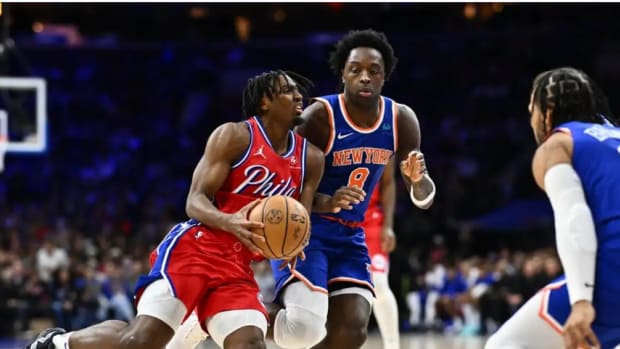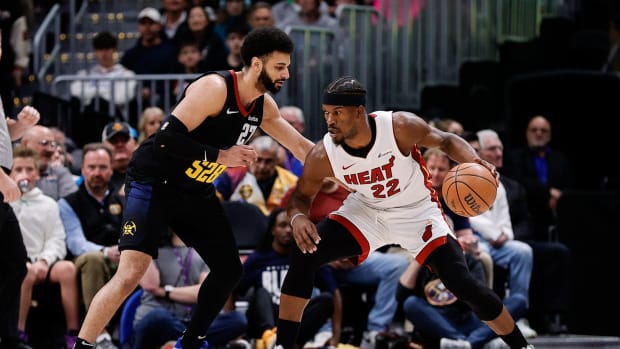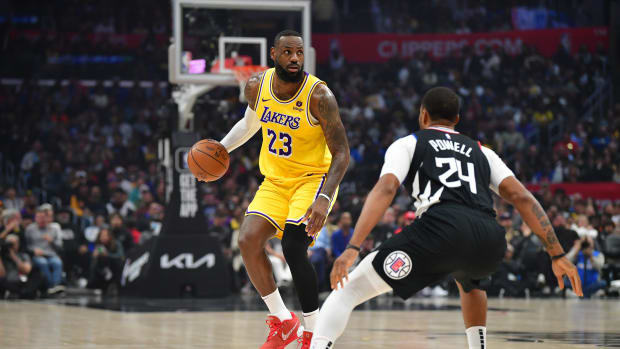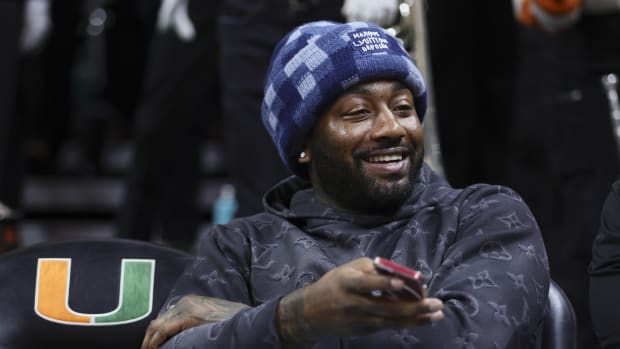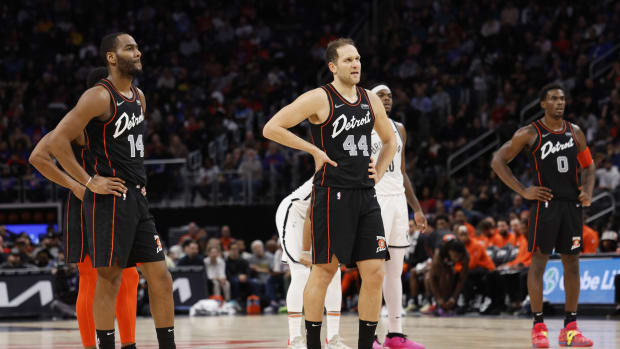Judge Rules in Favor of 'NBA 2K' Creators in Case Brought by Tattoo Artists
When the NBA eventually returns from hiatus, we’ll once again see dunks, blocks, steals and . . . tattoos. One study has found that about 56% of NBA players are tattooed. In contrast, approximately 35% of American adults are inked, though among millennials the percentage is a more-NBA-like 47%. Many NBA players are adorned with multiple tattoos. By one count, Philadelphia 76ers forward Mike Scott has an eye-catching 45 of them.
The prevalence of tattoos on NBA players is not a legal issue. However, the depiction of those tattoos in video games has become a unique controversy impacting both the sports and gaming communities.
So, who “owns” a video game representation of an NBA player’s tattoo? There are several possibilities, including: the tattooist who designed the tattoo; the real-life player whose skin shows the tattoo; the company that created the code for the video game; the video game player who paid for the game; the public at large; or no one.
This question centers on the likenesses of NBA players as displayed through avatars in the popular game series NBA 2K. On Mar. 26, Judge Laura Taylor Swain of the U.S. District Court for the Southern District of New York issued a ruling that will be studied closely by copyright attorneys and legal scholars. It’s also a ruling that could face a federal appeal. Judge Swain granted summary judgment in favor of 2K Games and Take-Two Interactive Software, the publishers of NBA 2K. They are defendants in a case brought by a company that disputes the game’s display of players’ tattoos.
NBA 2K, the licensing of NBA players’ likenesses and tattoos
NBA 2K is familiar to most sports fans. A new version of the series is published annually. At full price, the game retails for $59.99. In 2019, NBA 2K20 was the second-highest selling video game behind Call of Duty: Modern Warfare 2019 and ahead of Madden NFL 20. As of two months ago, NBA 2K20 had sold eight million units. NBA 2K20 is also featured in the NBA’s esports league, a joint venture between the NBA and Take-Two. Real NBA players are currently taking part in an NBA 2K tournament.
The success of the NBA 2K series partly reflects the game’s intense realism. NBA 2K’s avatars are intended to resemble their real-life counterparts as closely as possible. This is true in how the avatars represent players’ skills and physical appearances, right down to the fine details of tattoos. In fact, NBA 2K players can purchase additional tattoos through “microtransactions,” which are in-game purchases that unlock added features.
The licensing of NBA players’ names, images and likenesses—save for tattoos—is not a legal controversy. The NBA and the National Basketball Players’ Association have crafted policies that explicitly authorize this licensing. Take-Two pays a hefty fee, shared by the league and players, for the right to digitize all “things” that make the NBA so distinctive. Last year, Take-Two agreed to pay up to $1.1 billion over a seven-year period for the ability to publish games with NBA properties. Lifelike representations of team logos, arenas and players can thus be lawfully featured in NBA 2K games. This arrangement seems like a win for everyone, including the millions of people who play the game on their Sony PlayStation 4, Microsoft Xbox One, Nintendo Switch, Google Stadia, PC, Mac and other devices and platforms.
Well, not so fast. Not everyone agrees that it’s a “win.” And not everyone agrees this arrangement is entirely legal.
Enter the tattoo artists whose designs appear in NBA 2K. They aren’t part of Take-Two’s billion-dollar contract with the NBA. They haven’t been paid, either. Should they have been?
The copyright case against NBA 2K
Four years ago, Solid Oak Sketches, a company that holds copyright license agreements with tattooists who have inked NBA players, filed its complaint in federal court. Solid Oak has been represented by attorneys Darren Heitner, Paul Haberman and Matthew Spirtz, while the defendants have retained attorneys Dale Cendali, Catherine Seibel, Emma Raviv and Joshua Simmons.
Solid Oak argues that the defendants infringed on the copyrights connected to the tattoos. The company’s complaint focuses on five tattoos that are depicted on avatars associated with LeBron James, Kenyon Martin and Eric Bledsoe in the 2K14, 2K15 and 2K16 games. Solid Oak insists that Two-Take had no right to publicly display those tattoos without its permission.
Solid Oak’s basic legal argument hinges on the application of copyright law to tattoos and an assessment of whether digitizing the tattoos is allowable via certain defenses, including de minimis use and implied license.
A brief primer on copyright law may be helpful. A copyright exists from the moment the work is created and fixed in tangible form. A photograph, novel and other artistic productions can all be copyrighted. Broadly speaking, copyright law attempts to balance protections for content creators with access to creative works. If it was very easy to “steal” someone else’s work, there would be less incentive for creativity. At the same time, public access to creations helps to promote knowledge and can spark further innovation.
Holders of copyrights generally enjoy the right to control the reproduction of their creative works. They can thus demand financial compensation for a license. That issue is at the heart of photographer Steve Mitchell’s ongoing copyright infringement case against LeBron James. Without Mitchell’s permission, James used Mitchell’s photos of him in social media posts.
There are two core requirements for a work to obtain copyright protection. One is originality and the other is fixation. Originality is straightforward. A tattoo design must be original and not copied.
The second requirement, fixation, is a little more intricate. Under the federal Copyright Act, a work is “fixed” in a tangible medium of expression “when its embodiment . . . is sufficiently permanent or stable to permit it to be perceived, reproduced, or otherwise communicated for a period of more than transitory duration.” A tattoo reflects a design imprinted onto the skin. Specifically, a needle inserts ink into the dermis layer, thereby altering the pigment. Absent a removal procedure, the imprint is permanent.
Previous cases involving athletes’ tattoos and representation in video games
Tattoos can be copyrighted. There have also been noteworthy copyright cases involving tattoos of NBA players and video games showing athletes’ tattoos. However, those cases settled out of court, meaning they don’t provide precedent.
One of those cases involved retired NBA player Rasheed Wallace. In 2005, a tattooist named Matthew Reed sued Nike and Wallace, who at the time played for the Detroit Pistons, for infringement. The case concerned a tattoo on Wallace’s arm. Reed had designed the tattoo with Wallace’s involvement. The tattoo was then featured in a Nike commercial. Did Wallace and Nike need Reed’s permission for the commercial, or did they gain that right as part of Wallace hiring Reed to create the tattoo? We’ll never know: the case ended in a settlement.
Seven years later, a tattooist named Christopher Escobedo sued video game publisher THQ over the game UFC Undisputed 3. The game showed a representation of a lion tattoo on the rib cage of MMA fighter Carlos Condit, whose name, image and likeness had been licensed to appear in the game. Escobedo had registered a sketch of the tattoo with the U.S Copyright Office. Escobedo claimed that he never granted a license for his design to appear in a video game. The case was resolved without a decision on the merits in part because THQ filed for Chapter 11 bankruptcy. However, a bankruptcy court later awarded Escobedo $22,500. Although the bankruptcy court never explained its award to Escobedo, the fact that it awarded him money signaled his case may have had some merit. Escobedo later appealed the award on grounds that the dollar amount was insufficient. He would reach a settlement out of court.
The Solid Oak case is similar to the one brought by Escobedo. Both involve a sports video game’s representation of a tattoo on an athlete whose name, image and likeness lawfully appear in the game. The core question is whether the license to the athlete’s likeness encompasses tattoos. If the tattoo is part of the athlete’s appearance, like other skin features, the video game company would have a stronger argument that it didn’t need to pay the tattooist. But if the tattoo design is a distinguishable feature that isn’t covered in a licensing agreement, the tattooist would likely be advantaged.
Unpacking Judge Swain’s ruling
Take-Two persuaded Judge Swain to dismiss Solid Oak’s complaint through summary judgment. It did so primarily by stressing that the use of tattoos on James, Martin and Bledsoe was de minimis and that Take-Two had implied authorization. Take-Two also convinced Judge Swain that the doctrine of fair use applies. By entering summary judgment, the judge concluded that no reasonable trier of fact could find for Solid Oak.
It’s worth unpacking Judge Swain’s conclusions. First consider de minimis use. In order for a copyright infringement claim to prevail, the amount of copied material must be more than trivial. Judge Swain’s ruling focuses on the minimal presence of tattoos in the game. She observes that “NBA 2K users do not see the tattoos clearly, if at all, during gameplay” and that tattoos are only apparent as part of a player’s avatar.
Judge Swain further maintains the tattoos of the three players in question only appear on screen at a size of 4.4% to 10.96% of their actual sizes. In addition, the tattoos only reflect between only 0.000286% to 0.000431% of the game’s data. For those reasons, the judge concludes, the video game-version of the tattoos aren’t substantially similar to the real ones. During the litigation, Take-Two’s defense insisted that because NBA players’ avatars are both moving quickly on-screen and jostling for position with other avatars (like real NBA players would do in a real game), and because the tattoos are relatively small, the typical gamer’s eyes seldom observes the tattoos as nothing more than a blur. Along those lines, the defense asserted that the tattoos are no more noticeable than the nose shape of a player’s avatar.
Judge Swain also reasons that the tattoos are not an important part of the video game itself. She notes that tattoos aren’t featured in any of the game’s marketing materials. The judge’s ruling also draws attention to consumer data, provided by an expert witness retained by the defense. The data showed that consumers don’t buy NBA 2K games because of players’ tattoos.
Judge Swain also places importance in the fact that Solid Oak has never licensed its designs in video games. The absence of such licensing arguably implies there is no intellectual property requiring a license.
Take-Two also presented Judge Swain with an influential argument that the company possessed an implied license through its express contract with the NBA. This purported license, Take-Two maintained, included tattoo designs. In other words, even if the contract with the NBA didn’t mention tattoos, it nonetheless implied a right to include tattoos as part of the players’ likenesses.
The word “implied” is therefore crucial. It means that Take-Two had no explicit license to use the tattoo designs. The company overcame this hurdle by obtaining key testimony from the tattooists. They retold how James, Martin and Bledsoe all requested certain types of individualized tattoos, how those tattoos were then designed and, lastly, inked onto the players’ skin. As summarized by Judge Swain, the tattooists also acknowledged that they knew players would display their tattoos in public, including in commercials and in other forms of media. In other words, the tattoos had seemingly become part of the players’ likenesses, just like the rest of their bodies.
Take-Two also prevailed by arguing that its use of the tattoo designs reflected fair use. The Copyright Act allows for the fair use of a copyrighted work for such purposes as criticism, comment, news reporting and research. When fair use applies, copying another’s work is not infringement.
In determining if fair use is present, courts consider (among other factors) whether the use is “transformative.” A transformative use is one that has a different purpose from the original purpose.
Here, Judge Swain highlights that the two sets of tattoos—the real ones and those in the video game—were designed for very different purposes. Tattooists crafted the tattoos to reflect the expression of a player’s identity. James, for example, hired tattooist Justin Wright to craft a tattoo that incorporated a baby picture. This tattoo, dubbed Child Portrait, was about James expressing himself in a personal way. Now consider why Take-Two programmers replicated that same Child Portrait tattoo. They did so to make James seem as real as possible in NBA 2K. From that lens, the tattoos in NBA 2K are not about players expressing themselves but rather about making the game mimic everything about the players.
Next steps
The case is over—for now. Solid Oak could appeal Judge Swain’s order to the U.S. Court of Appeals for the Second Circuit. Given how this legal topic is relatively new and very debatable, Solid Oak might see the value in petitioning a panel of three appellate judges to review the same set of issues. During the litigation, Solid Oak’s attorneys repeatedly argued that the tattoo licensing agreements never contained a right for Take-Two to use the tattoos. It’s possible that line of reasoning might prove more persuasive on appeal.
We’ll keep you posted on key developments.
Michael McCann is SI’s Legal Analyst. He is also an attorney and the Director of the Sports and Entertainment Law Institute at the University of New Hampshire Franklin Pierce School of Law.






























